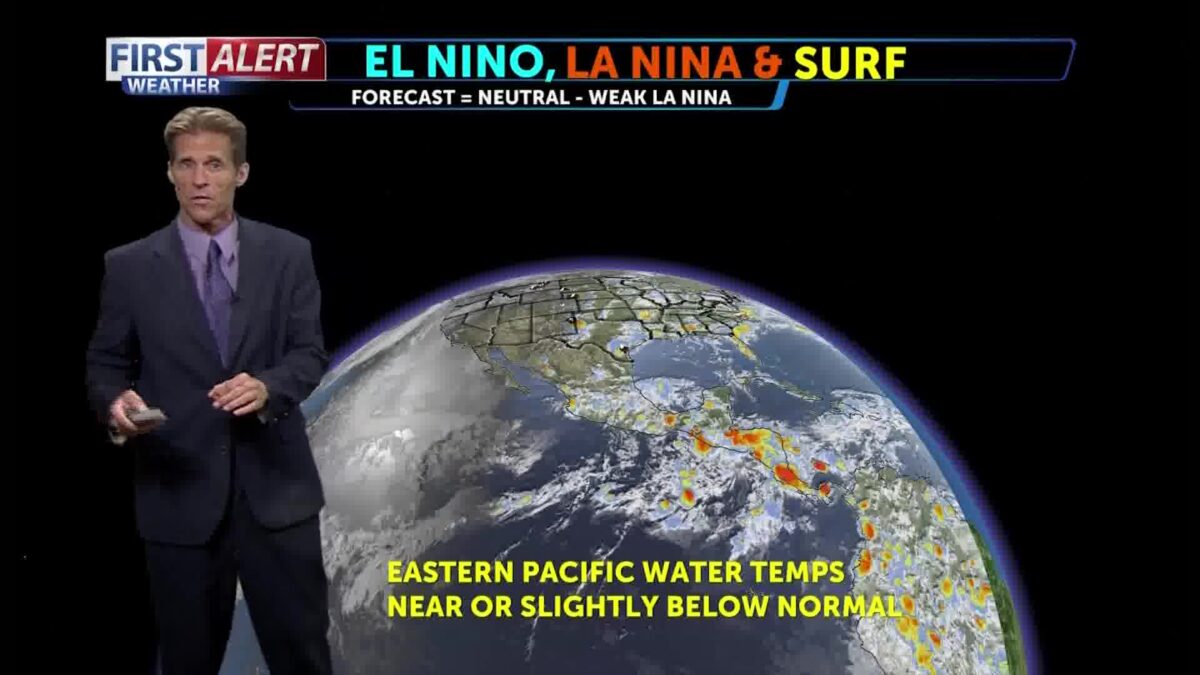Preparing for La Niña: How It Could Impact the Coast, Crops, and Communities in Southern California

Ryder Christ
SANTA BARBARA, Calif. — From worsening wildfires to eroding coastlines and crop losses, changing climate patterns are reshaping life along the Central and Southern California coast. Experts say the effects could intensify as the region transitions into a La Niña phase later this year.
Currently, the region is experiencing a neutral climate pattern—a transitional period between El Niño and La Niña. “Think of this neutral phase as a climate reset or a transition period,” Chief Meteorologist Mackenzie Lake explained, noting that the last El Niño brought wetter conditions to California, fueling storms and floods. That wet season, however, is likely to give way to a drier, more fire-prone La Niña by late summer.
A La Niña pattern often brings stronger winds that push warm ocean water westward, allowing cooler water to rise to the surface. This typically results in drier weather across Southern California, increasing the risk of wildfires.
“We’re starting to see that seasonal shift toward drier vegetation and some smaller fires already,” said Robbie Munroe, a meteorologist with the National Weather Service. “That’s a signal we’re in fire season, and things will likely get worse from here.”
So far in 2025, more than 57,000 acres have burned across Southern California, including the Kenneth Fire in Ventura County, which scorched over 1,000 acres in January amid intense Santa Ana winds.
Santa Ana winds—hot, dry gusts that blow from inland deserts toward the coast—can rapidly escalate wildfires. Similar threats exist in Santa Barbara County, where sundowner winds blow from the northwest down mountain slopes and are notorious for driving fast-moving fires.
In response, fire agencies are urging residents to prepare early by creating go-bags and clearing vegetation around their homes.
While shifting climate phases bring risks, they also create opportunities—especially for surfers. First Alert Forecaster Shawn Quien says ocean temperatures in the eastern Pacific are holding steady as we move into a neutral climate phase, helping to fuel more consistent summer surf. Looking ahead, forecasters expect the winter storm track to dip farther south than it did during last year’s La Niña, when storms stayed to the north and surf conditions suffered. This potential shift could bring bigger and more reliable waves to California’s coast during the peak winter months.
The impacts of the recent El Niño season are still being felt. More than 50 atmospheric rivers pummeled the state, triggering landslides, flooding, and severe coastal erosion. One of the hardest-hit areas was Isla Vista, where rising sea levels and powerful waves continue to eat away at the oceanfront cliffs. “Rising sea levels mean those waves are going to hit farther inland and with more energy over time,” said Charles Lester, director of UC Santa Barbara’s Ocean and Coastal Policy Center. Along Del Playa Drive, erosion has already caused balconies to collapse into the ocean, threatening homes built dangerously close to the edge.
Meanwhile, hurricane season, which officially began May 15, presents another set of risks. While tropical systems like Hurricane Barbara and Tropical Storm Dalia aren’t expected to make landfall in California, they can still send powerful ocean swells and dangerous rip currents toward the coast. Just last year, Hurricane Hilary brought record-setting rainfall and hazardous surf to Southern California.
In Santa Barbara County’s agricultural sector, farmers are bracing for more instability. Strawberry growers—including Sunlife Farms in Santa Maria—are still recovering from last year’s severe storms, which caused more than $56 million in crop losses countywide. Flooding not only destroyed fields but also introduced bacterial contamination, forcing growers to discard large portions of their harvest.
La Niña’s potential to bring extended heat waves poses additional challenges, as excessive heat can cause strawberries to overripen before they can be harvested. Santa Maria’s strawberry season typically runs from April to November, with late-summer heat threatening both yield and quality.
Further north in San Luis Obispo County, wine grapes have overtaken strawberries as the region’s top crop. The latest crop report shows grapes generating more than $300 million in value.
Still, winemakers like Mikee Mott at DAOU Vineyards are watching climate shifts closely. Variations in temperature and weather patterns can significantly affect the flavor profile and quality of their wines.
With wildfires, agriculture, coastal erosion, and hurricane impacts all tied to shifting climate patterns, local experts say communities must adapt quickly—and stay informed.